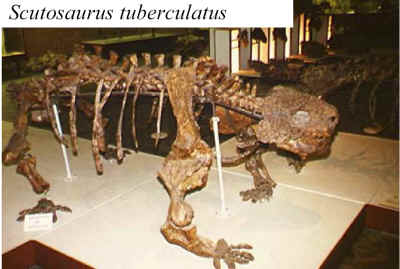 Anapsida (= Parareptilia):
Anapsida (= Parareptilia): | Anapsida | ||
| The Vertebrates | Anapsida or Parareptilia? |
| Vertebrates Home | Vertebrate | Vertebrate |
|
Abreviated Dendrogram
Reptiliomorpha
├─Synapsida
└─┬─Eureptilia
│
└─Anapsida/Parareptilia
├─┬─Millerettidae
│ └─Eunotosaurus
├─Mesosauridae
└─┬─Lanthanosuchoidea
└─┬─Bolosauridae
└─Procolophonia
├─┬─Nycteroleteridae
│ └─Pareiasauridae
└─Procolophonoidea
├─Owenettidae
├?─Testudines
└─Procolophonidae
|
Contents
Overview |
Parareptilia ("at the side of reptiles") is an alternative term for a clade of early amniotes which are variously defined as an extinct group of primitive "reptiles", or a more cladistically correct alternative to Anapsida. Whether the term is valid or even useful depends a lot on the phylogenetic position of turtles, the relationships of which to other reptilian groups are still uncertain, as well as on ever shifting trends in popularity of terms.
A bit of history. The name Parareptilia was coined by Olson 1947 to refer to an extinct group of Paleozoic reptiles, as opposed to the rest of the reptiles or Eureptilia ("true reptiles"). The name soon fell into disuse, until it was revived by cladistic studies, to refer to anapsida that were thought unrelated to turtles. Gauthier et al. 1988 provided the first phylogenetic definitions for the names of many amniote taxa, including Sauropsida as the parent clade for Reptilia, and argued cladistically that captorhinids and turtles (or "Testudines" to give the technical scientific term) were sister groups, constituting the clade Anapsida (in a much more limited context than the definition given by Romer 1966). A name had to be found for various Permian and Triassic reptiles no longer included in the Anapsids, and "Parareptiles" was chosen. However, they did not feel confident enough to erect Parareptilia as a formal taxon. Their cladogram was as follows:
Laurin and Reisz 1995 presented a different cladogram, in which the Reptilia are divided into Parareptilia (now a formal taxon) and Eureptilia. The Captorhinidae are transferred to the Eureptilia, and the Parareptilia includes both early Anapsid reptiles and turtles, but not the Captorhinidae and Protorothyrididae. The mesosaurs are placed outside both groups, as the sister taxon to the reptiles (but still sauropsids). The traditional taxon of Anapsida is rejected as paraphyletic. This gives the following:
The term Parareptilia has also been adopted by Russian workers, who have discovered a number of interesting lineages of early anapsid reptiles from the Middle Permian. They also follow a fairly standard classification of turtles.
In contrast, Rieppel, 1994, 1995; Rieppel & deBraga, 1996; and deBraga & Rieppel, 1997 have argued that turtles are actually related to sauropterygia, and hence are diapsids. They give this cladogram (the following is from deBraga & Rieppel, 1997, care of dinosaur mailing list archives):
The diapsid affinities of turtles is unanimously supported by molecular phylogeny (e.g. Zardoya and Meyer 1998). This makes the Parareptilia a wholly extinct clade. I (MAK) have adopted this arrangement for now and followed the molecular concensous that turtles are diapsids and probably archosaurs. However this hypothesis is not very widely accepted among vertebrate paleontologists, and Benton 2000, 2004, retains the traditional class Anapsida for the "parareptiles" and turtles. (see Chelonian origins for more)
Regardless of whether one says "anapsid" or "parareptile", these animals formed an important element of Middle Permain terrestrial ecosystems, and these small to occasionally medium-sized lizard-like insectivorous and herbivorous forms were doubtless more numerous and diverse than their few scattered fossil remains indicate. It seems that most of these little animals did not survive the end-Gaudapadian mass extinction, their place taken by Owenettids and a few relict Millerettids in the late Permian, while a single lineage, the Pareiasaurids, grew to huge size during the later Middle Permian and survived till the end of the period. In the Triassic period, in the wake of another mass extinction, the end Permian extimnction, a single anapsid lineage, the Procolophonids, became enormously successful and diverse as small terrestrial herbivores. MAK09xxxx
 Anapsida (= Parareptilia):
Anapsida (= Parareptilia):
from the Permian
Sauropsida : Eureptilia + * : Mesosauridae + (Millerettidae + Eunotosaurus) + Procolophonomorpha
MAK120323
Caniniform teeth absent; posterior emargination of skull; dorsal expansion of quadratojugal; expanded iliac blade. Classically, no posttemporal fenestra; but this could be derived from the diapsid condition.
ATW030912
Anapsida
├─Mesosauridae
└─Parareptilia
├─Millerettidae
└─Procolophonia |
Comments: The term Anapsida has also been used for Mesosauridae + all other anapsids; with this latter clade, the sister taxon of Mesoauridae,is called Parareptilia (see dendogram right).
(Reisz & Scott 2002; also see Modesto & Anderson 2004 for general discussion of clade names). For reasons explained elsewhere, we have chosen not to incorporate that phylogeny. Throughout these pages then, anapsida and parareptilia are used synonymnously and interchangeably MAK120323
Links: Introduction to the Anapsids; Phylogeny & Classification of Amniotes; Parareptiles; Reptiles - Subclass Anapsida; Anapsida -- The Dinosauricon; Anapsida; Basal Anapsida after Berman et al., 2000, Lee, 1993, 1996 and ...; Literature - Anapsida; F el ning 5; Nathis Fauna Reptilelen. ATW030912.
Image: from F el ning 5 Lecture notes of Prof. John Peel & Prof. Lars Holmer, Uppsala Universitet, Department of Earth Sciences). Scutosaurus is a well-known pareiasaur. ATW030912
checked ATW040118, revised MAK111115, 120323